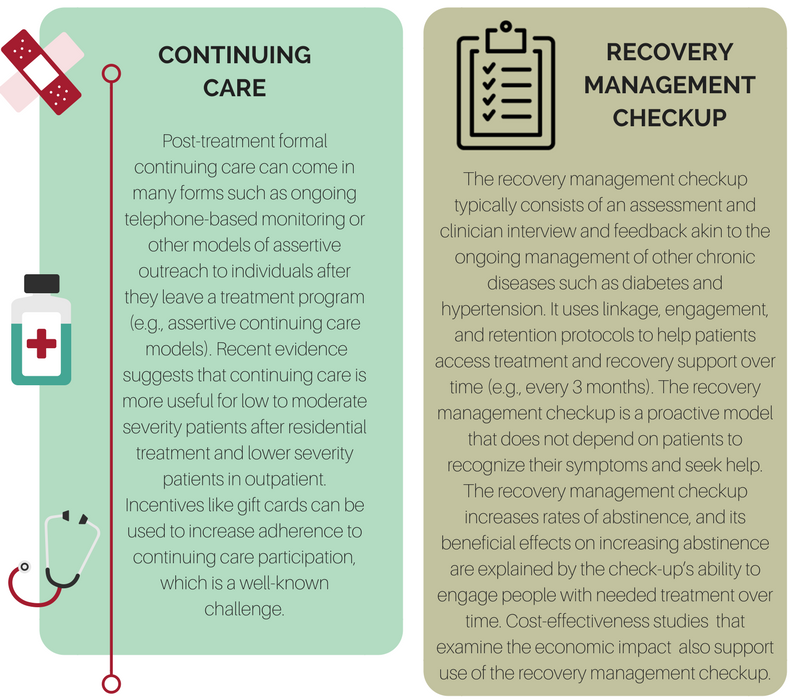Is Residential or Outpatient Treatment Alone Enough to Treat Substance Use Disorders?
The science of continued support following residential & outpatient treatment. Does one work without the other?
WHAT PROBLEM DOES THIS STUDY ADDRESS?
Substance use disorders, including both alcohol and other drug (i.e., opioid) use disorders, are frequently discussed as chronic health conditions, but have been treated typically in acute care format with detoxification and stabilization and some amount of brief episodic treatment. As such, the vast majority of research on the course of substance use disorder is based on treatment samples with limited follow-up periods. However, people in recovery are susceptible to relapse for many years after initiating abstinence.
Specifically, we know that it takes 4-5 years of continuous remission before the risk of relapse in the following year drops below 15% – i.e., the risk for meeting criteria for a substance use disorder in the following year is no higher than the risk in the general population. Ongoing monitoring and early re-intervention are essential in managing chronic health conditions, such as substance use disorders. Early detection can minimize the harmful consequences and promote avenues for recovery.
This article summarized recent advances in:
- continuing care
- recovery management checkups
- self-help or peer support
- technology-integrated interventions
(all above can be used for on-going monitoring after treatment for substance use disorder).
HOW WAS THIS STUDY CONDUCTED?
In this study, authors used their expertise in the field of treatment and recovery from substance use disorder among adolescents and young adults to review the current evidence and outline future directions
WHAT DID THIS STUDY FIND?

https://www.recoveryanswers.org/research-post/warrior-check-ups-improving-alcohol-treatment-for-military-members/
https://www.ncbi.nlm.nih.gov/pmc/articles/PMC2885472/

https://www.recoveryanswers.org/research-post/21st-century-addiction-treatment-integrating-technology-into-community-programs/
https://www.ncbi.nlm.nih.gov/pmc/articles/PMC3558929/
https://www.ncbi.nlm.nih.gov/pmc/articles/PMC3117904/
https://www.ncbi.nlm.nih.gov/pmc/articles/PMC3062700/
https://www.ncbi.nlm.nih.gov/pubmed/21190401
WHY IS THIS STUDY IMPORTANT?
The treatment of substance use disorders has often been limited to a medical intervention (i.e., detox) and brief episodic treatment. Treatment modalities that are limited in duration can be a poor fit given the recurrent course of substance use disorders and tend to perform more poorly for many compared to ongoing care of some kind.
This review of recent research highlights scientific advances in ongoing recovery management and provides a basis for implementing empirically supported approaches to help monitor recovery after treatment. This body of evidence expands the options needed to support remission with continuing care models, recovery management checkup, mutual help organizations, and technology-assisted management.
- LIMITATIONS
-
- This article was a narrative review as opposed to a systematic review. Consistent with a narrative review the articles discussed were based on the authors selection as opposed including all articles that meet certain inclusion criteria. This means there exists potential for excluding relevant articles.
- Furthermore, this is a qualitative summary of the studies as opposed to a statistical summary found in a meta-analysis so the conclusions were not reached through empirical data analysis.
NEXT STEPS
The field would benefit from additional research on long term disease management services, such as mutual help organizations, the recovery-management checkup with different populations, and more on sober living environments.
BOTTOM LINE
- For individuals & families seeking recovery: Substance use disorders are treatable chronic health conditions often characterized by a course of alternating periods of remission and relapse before long-term sustained remission is achieved. As a result, ongoing support through formal continuing care, recovery management checkups, participation in mutual help organizations, and technology-integrated services are helpful after residential or outpatient treatment.
- For scientists: Learning which approach to ongoing support works best for whom is critical. For example, as the authors mention, individuals 18-25 years old represent over half the people in drug courts and are the fastest growing population of people with opioid use disorders. Despite this trend, 18-25 year olds are one of the least commonly studied age groups. Prospective studies are needed to inform the field about new tools like alternative peer groups (APGs) and campus-based collegiate recovery programs given their ability to reach this demographic.
- For policy makers: There is strong evidence indicating that substance use disorder is a chronic relapsing brain disease. Because it can take some time after abstinence has been initiated for the brain systems to recalibrate and to adapt to the absence of drugs, services should be provided in an ongoing way after an acute residential or outpatient treatment. The science reviewed here showed four empirically supported options including formal continuing care interventions, recovery management checkups (which provide ongoing assessment over several years and intervenes only when necessary), mutual help organizations, and technology-assisted services and details the circumstances in which each service works best to reduce substance use. Consider prioritizing the necessary policy and funding decisions that would foster an ongoing approach to recovery monitoring after residential or outpatient treatment.
- For treatment professionals and treatment systems: Educate your patients and families on how substance use disorder is a chronic health condition that requires on-going support after acute treatment stabilization similar to other chronic health conditions. Patients often underestimate what it takes to stay in remission over time. Science has shown that formal continuing care, recovery management checkups, mutual help organizations, and certain types of technology-based platforms are empirically supported and can reduce substance use, shorten the length of relapses, and increase the likelihood of initiating and sustaining remission. Consider informing patients about the different services available and the possibility of multiple pathways to recovery.
CITATIONS
Dennis, M.L., Scott, C.K., & Laudet, A. (2014). Beyond bricks and mortar: Recent research on substance use disorder recovery management. Current Psychiatric Reports, April 16(4), 442. doi: 10.1007/s11920-014-0442-3

